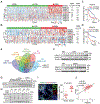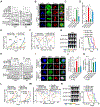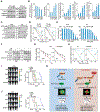PRMT6 methylation of RCC1 regulates mitosis, tumorigenicity, and radiation response of glioblastoma stem cells
- PMID: 33539787
- PMCID: PMC7979509
- DOI: 10.1016/j.molcel.2021.01.015
PRMT6 methylation of RCC1 regulates mitosis, tumorigenicity, and radiation response of glioblastoma stem cells
Abstract
Aberrant cell proliferation is a hallmark of cancer, including glioblastoma (GBM). Here we report that protein arginine methyltransferase (PRMT) 6 activity is required for the proliferation, stem-like properties, and tumorigenicity of glioblastoma stem cells (GSCs), a subpopulation in GBM critical for malignancy. We identified a casein kinase 2 (CK2)-PRMT6-regulator of chromatin condensation 1 (RCC1) signaling axis whose activity is an important contributor to the stem-like properties and tumor biology of GSCs. CK2 phosphorylates and stabilizes PRMT6 through deubiquitylation, which promotes PRMT6 methylation of RCC1, which in turn is required for RCC1 association with chromatin and activation of RAN. Disruption of this pathway results in defects in mitosis. EPZ020411, a specific small-molecule inhibitor for PRMT6, suppresses RCC1 arginine methylation and improves the cytotoxic activity of radiotherapy against GSC brain tumor xenografts. This study identifies a CK2α-PRMT6-RCC1 signaling axis that can be therapeutically targeted in the treatment of GBM.
Keywords: CK2; GBM; GSC; PRMT; RCC1; arginine methylation; mitosis; phosphorylation; therapy response; tumorigenicity.
Copyright © 2021 Elsevier Inc. All rights reserved.
Conflict of interest statement
Declaration of interests The authors, and their immediate family members, are not members of the Molecular Cell advisory board. The authors declare no further competing interests.
Figures







Comment in
-
Keep it focused: PRMT6 drives the localization of RCC1 to chromosomes to facilitate mitosis, cell proliferation, and tumorigenesis.Mol Cell. 2021 Mar 18;81(6):1128-1129. doi: 10.1016/j.molcel.2021.02.026. Mol Cell. 2021. PMID: 33740472
References
-
- Azuma Y, Renault L, Garcia-Ranea JA, Valencia A, Nishimoto T, and Wittinghofer A (1999). Model of the ran-RCC1 interaction using biochemical and docking experiments. J Mol Biol 289, 1119–1130. - PubMed
Publication types
MeSH terms
Substances
Grants and funding
- R01 NS095642/NS/NINDS NIH HHS/United States
- R01 CA201402/CA/NCI NIH HHS/United States
- R01 NS102669/NS/NINDS NIH HHS/United States
- P30 CA060553/CA/NCI NIH HHS/United States
- K00 CA234799/CA/NCI NIH HHS/United States
- R01 NS093843/NS/NINDS NIH HHS/United States
- P50 CA221747/CA/NCI NIH HHS/United States
- F31 CA232630/CA/NCI NIH HHS/United States
- R01 CA236356/CA/NCI NIH HHS/United States
- R01 NS117104/NS/NINDS NIH HHS/United States
- R01 CA213293/CA/NCI NIH HHS/United States
- R01 AG054429/AG/NIA NIH HHS/United States
- R01 NS095634/NS/NINDS NIH HHS/United States
- R21 CA209345/CA/NCI NIH HHS/United States
- R01 NS115403/NS/NINDS NIH HHS/United States
- R01 NS107071/NS/NINDS NIH HHS/United States
- P30 CA008748/CA/NCI NIH HHS/United States
- UL1 TR001422/TR/NCATS NIH HHS/United States
LinkOut - more resources
Full Text Sources
Other Literature Sources
Medical
Molecular Biology Databases
Research Materials
Miscellaneous

